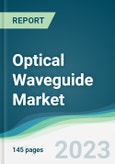The global optical waveguide market is expected to grow at a CAGR of 7.15% during the forecast period between 2025 and 2030.
A waveguide is a tool or substance that can direct waves in a certain direction. Waveguides minimize wave intensity loss while assisting wave propagation from a source to a different specified place. During this procedure, the wave is constrained to a specific dimensional path, preventing it from spreading in all directions. Waveguides are utilized in the fiberoptic cables that provide broadband internet, microwave ovens to direct microwaves, and the sophisticated scientific apparatus used in the physical sciences and medicine.
A waveguide is a tool or substance that can direct waves in a certain direction. Waveguides minimize wave intensity loss while assisting wave propagation from a source to a different specified place. During this procedure, the wave is constrained to a specific dimensional path, preventing it from spreading in all directions. Waveguides are utilized in the fiberoptic cables that provide broadband internet, microwave ovens to direct microwaves, and the sophisticated scientific apparatus used in the physical sciences and medicine.
Market Trends:
- Advancements in photonic integrated circuits (PICs) driving market growth: Photonic integrated circuits (PICs), which use photons or light for data transmission, are expected to significantly boost market expansion. These circuits incorporate optical components like waveguides, polarizers, and phase shifters, functioning similarly to resistors, transistors, and capacitors in electronic circuits. PICs offer advantages such as compact size, low transmission loss, high bandwidth, immunity to electrical short circuits, and resistance to electromagnetic interference. Emerging applications in data center interconnects, communication, high-performance computing, and optical computing are driving the adoption of PICs. Companies are focusing on developing advanced PIC solutions to meet growing market demands. For example, in December 2022, OpenLight (US) introduced an 800G DR8 PIC designed for data center interconnect (DCI) applications, which has been extensively validated for use in DCI transceivers. Such innovations are expected to accelerate the growth of the optical waveguide market.
- Challenges in design and fabrication: The widespread adoption of optical waveguides is hindered by complexities in their design and manufacturing. Optical waveguides require specialized physics and engineering expertise, as they are tailored to specific requirements and rely on particular transmission protocols. Additionally, they are costly, fragile, and susceptible to transmission losses. The need for robust, miniaturized components without compromising performance further increases design and fabrication expenses. These factors, along with lengthy production and deployment timelines, pose significant barriers to market growth.
- Regional market segmentation: The optical waveguide market is segmented into the Americas, Europe, the Middle East and Africa, and Asia Pacific. Asia Pacific is expected to dominate the market due to government initiatives supporting the photonics and semiconductor industries. For instance, in September 2022, the Indian government announced financial support covering 50% of capital expenditure (CAPEX) for companies establishing semiconductor, display, and silicon photonics manufacturing facilities. Such supportive policies are anticipated to drive the optical waveguide market's growth in the region during the forecast period.
Key Benefits of this Report:
- Insightful Analysis: Gain detailed market insights covering major as well as emerging geographical regions, focusing on customer segments, government policies and socio-economic factors, consumer preferences, industry verticals, and other sub-segments.
- Competitive Landscape: Understand the strategic maneuvers employed by key players globally to understand possible market penetration with the correct strategy.
- Market Drivers & Future Trends: Explore the dynamic factors and pivotal market trends and how they will shape future market developments.
- Actionable Recommendations: Utilize the insights to exercise strategic decisions to uncover new business streams and revenues in a dynamic environment.
- Caters to a Wide Audience: Beneficial and cost-effective for startups, research institutions, consultants, SMEs, and large enterprises.
What can businesses use this report for?
Industry and Market Insights, Opportunity Assessment, Product Demand Forecasting, Market Entry Strategy, Geographical Expansion, Capital Investment Decisions, Regulatory Framework & Implications, New Product Development, Competitive Intelligence.Report Coverage:
- Historical data from 2022 to 2024 & forecast data from 2025 to 2030
- Growth Opportunities, Challenges, Supply Chain Outlook, Regulatory Framework, and Trend Analysis
- Competitive Positioning, Strategies, and Market Share Analysis
- Revenue Growth and Forecast Assessment of segments and regions including countries
- Company Profiling (Strategies, Products, Financial Information, and Key Developments among others)
The Optical Waveguide Market is analyzed into the following segments:
By Type
- Planar Waveguide
- Channel Waveguide
By Material
- Glass
- Polymer
- Semiconductor
By Interconnect Level
- Metro and Long-haul Optical Interconnect
- Board-to-board and Rack-level Optical Interconnect
- Chip and Board-level Optical Interconnect
By Industry Vertical
- Telecommunication
- Medical
- Metrology
- Aerospace & Defense
- Consumer Electronics
- Industrial
- Others
By Geography
- Americas
- US
- Europe, the Middle East, and Africa
- Germany
- Netherlands
- Others
- Asia Pacific
- China
- Japan
- Taiwan
- South Korea
- Others
Table of Contents
1. INTRODUCTION
2. RESEARCH METHODOLOGY
3. EXECUTIVE SUMMARY
4. MARKET DYNAMICS
5. OPTICAL WAVEGUIDE MARKET BY TYPE
6. OPTICAL WAVEGUIDE MARKET BY MATERIAL
7. OPTICAL WAVEGUIDE MARKET BY INTERCONNECT LEVEL
8. OPTICAL WAVEGUIDE MARKET BY INDUSTRY VERTICAL
9. OPTICAL WAVEGUIDE MARKET BY GEOGRAPHY
10. COMPETITIVE ENVIRONMENT AND ANALYSIS
11. COMPANY PROFILES
Companies Mentioned
- Waveguide Optical Technologies
- Wave Optics Ltd.
- LUMUS
- Otinvent
- HFCL
- Sumitomo Bakelite Co., Ltd.
- OFS Fitel, LLC
- Corning Incorporated
- MicroVacuum Ltd.
- SAB Bröckskes GmbH & Co.
- Sumitomo Electric Industries, Ltd.
- Synopsys, Inc.
- Waveguide Communications, Inc.
Methodology

LOADING...








